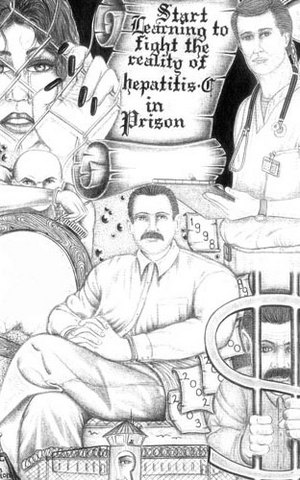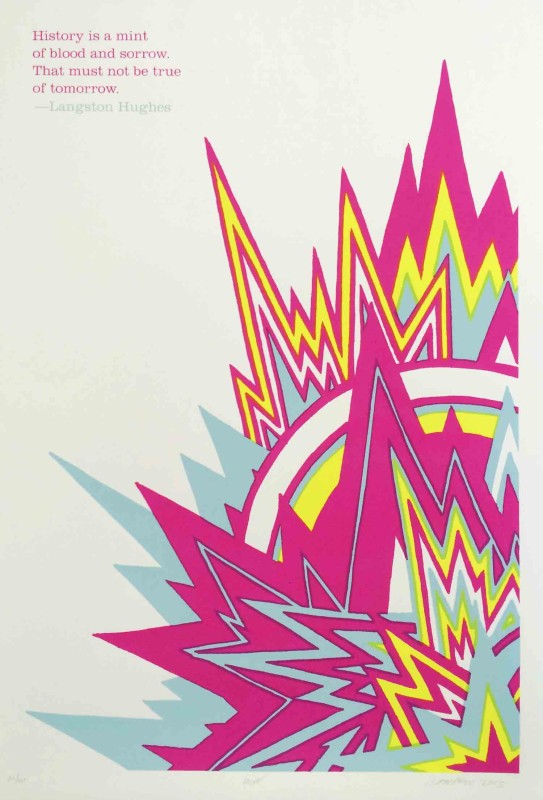Review:
Illustrations from the Inside: The Beat Within
edited by Louis E.V. Nevaer
Mark Batty Publisher, 2007
The Real Cost of Prisons
edited by Lois Ahrens
PM Press, 2008
Back in 1997, I was living in Boulder, CO and working with the Prisoners Rights Project, a group dedicated to improving the conditions of Colorado’s prisoners. We were mostly collecting and tabulating data and anecdotes from men trapped in the Colorado State Penitentiary, a super maximimum security prison and the ugly little brother of the Federal Florence AdMax prison down the street (there is something like a dozen prisons all on the same drag in Canyon City). I had been working on prison injustice issues for a number of years, first in Washington, DC, then Ohio, and then Colorado. One thing that was constant throughout my time doing prison activism were the envelopes from prisoners, tattooed with ball point pen dragons, big-breasted women, and low riders. These were some of the smallest, most intense and photo-realistic drawings I had ever seen; I had no idea the depth and detail one could extract from a Bic pen.
Illustrations from the Inside isn’t exactly a collection of prison envelope art, but it has all the best qualities of that art form and more. The book is an amazing collection of images created by juvenile prisoners that are part of The Beat Within, a long running weekly magazine and writing program for youth in juvenile detention and prison. The pages here are a rush of imagery, from Chicano clown faces to Black super heroes, prison bars to indigenous spirituality. In many ways this is a tour through the mind of most teenage boys, but with a darker twist, as even the most banal images begin to feel infected by fear, control, domination and violence. The quality of the art jumps from childish to some of the most intense social realism I’ve ever seen. Cartoon Tupac scribbles share space with detailed drawings of riot cops beating Black youth. In some ways Illustrations reads like an American youth version of that popular Russian Criminal Tattoos book, not as esoteric or x-rated, but a serious window into the mindset of 11-25 year old prisoners (yes, some of the images are from imprisoned youth as young as 11!).

It’s hard not to see the connections between this art and the popular art forms of tattooing and graffiti. Adam Mansbach seizes upon the similarities and difference to graffiti in his introduction to the book, raising the specter of burned out 1970s South Bronx, and how both art forms are the creative product of forgotten youth, kids thought of as the other, as dangerous, as criminals, as trash.
The writing in the book is pretty straightforward, which works. Mansbach gives us a basic intro, and then hands it over to editor Louis Nevaer. Nevaer, in direct and plain language, breaks down the structural reasons why class and race deeply effect who goes to prison and why, leading us to the reality of a majority poor youth of color juvenile justice system. The information is delivered in a straightforward way, nothing romantic or condescending. The one thing I am left wondering is: who is Nevaer? Unlike Mansbach, he has no bio, and he never clearly positions himself in his introduction. Why does he care? What is his connection to the youth or The Beat Within?
As always with Mark Batty Publishers, the book is beautiful. A nice hardcover, high quality paper, mostly black and white like the drawings, but with pink accents that highlight important written information in the pages facing the illustrations. And nice endpapers to top it all of, letting us know they care about book production and the book as an art object, not simply as a vehicle for information.
The Real Cost of Prisons covers similar material, but is a completely different take on it. This is primarily a paperback compilation of 3 comic books produced by the Real Cost of Prisons Project in order to educate prisoners and the public. The project is a nation-wide public education campaign designed to illustrate in plain and simple language what the real costs of prison are in our society. Since the 1970s the levels of incarceration in this country have skyrocketed, but there has been little to know public dialog about the reasons for this, or what it all costs, not just in financial terms, but the human costs. These comics were designed as popular education tools, and are being used as just that. Tens of thousands of copies have found their way into high school classrooms, prison study groups, politicians desks, and activist hands.
Comics are a powerful medium for breaking down complex ideas into frame by frame visual explanations, and that’s just what this book does. The Project was smart to approach 3 political comics veterans, all with experience working on World War 3 Illustrated, the longest running political comics magazine in the US. “Prison Town: Paying the Price,” drawn by Kevin Pyle, is an overview of how prisons are paid for, who pays the real costs and how prison construction effects the communities they are placed in. “Prisoners of the War on Drugs,” drawn by Sabrina Jones, exposes the forces at work behind drug laws and drug-related imprisonment. “Prisoners of a Hard Life: Women and their Children,” drawn by Susan Willmarth, is a touching collection of first person narratives about how prison has deeply affected women and children.
As this is an art bllog, let me talk a bit about the art. Kevin Pyle’s comic is a visual tour-de-force. Ever since his early World War 3 comics about prisons, I’ve always felt Pyle’s unique smudged drawing style perfectly captures the creepy feeling that prisons create; the idea something else is going on beyond what the eye can see, that the images, like the workings of state repression, won’t stand still long enough to get a clear image of what is really going on. Somewhat unfortunately this unsettled feeling carries into almost all his frames, even the ones focused on restorative justice and alternatives to the cruelty of prisons. Sabrina Jones is at her peak, using bold organic lines to powerfully carry us through the story and information. The material is dense and difficult, so I commend her efforts to tame it. My only complaint is that I would like to have seen more large images, full page graphics that frame the smaller panels and give us a macro view. Although Susan WIllmarth has done comics for World War 3 before, she is the artist I’m the least familiar with, but is an exciting surprise. I think her comic is my favorite, graphicly it reads as an exciting clash between Raymond Pettibone and Lynda Barry. It is much looser than the previous two stories, the raw style bringing us deep into the lives she’s narrating. I’m not a comics expert, but this seems like a great example of the comic books’ visual narrative structure being used to compelling lay out important social and political material.
These two books illustrate two very different possible relationships between art and social injustice. The Real Cost of Prisons uses art by practiced professionals as a tool to teach about and explain issues to wide and diverse audiences. It plays to the strengths of an established form (the comic) and lays out a clear path for the reader to better understand the workings of the US prison system. On the other hand, Illustrations from the Inside argues that creativity is a raw tool for the liberation of the creator. The audience is secondary; we are voyeurs, allowed a quick peek into the lives of kids in prison. The art can educate people, that is much less important than the possible transformative effect it can have on the artists themselves.











love the art….i did a 10 yr bid in The Texas Department of Criminal Justice. 1997-2007. I learned how to tattoo in prison,and did lots of drawing…I am now a professional tattoo artist. So I guess you could say i learned a trade in prison. Just not one they wanted me to learn.
…THIS IS AWESOME .. WORK !
I love these illustrations. This is just remarkable tattoo material.
Thanks.
Beautiful work really !!!!!! Art work is beautiful